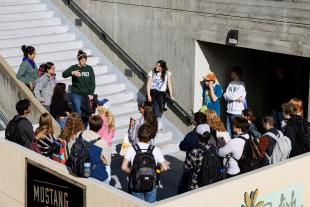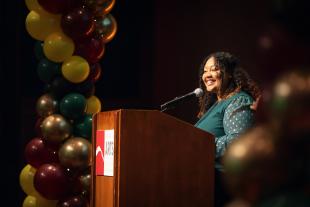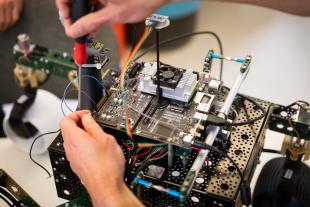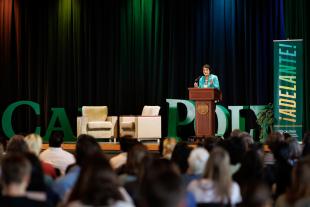Professors Talk Equity, Inclusion at Fourth Annual Teach In
“What does it mean to be black in America?” Ethnic Studies chair Denise Isom asked a crowd gathered in Kennedy Library on a sunny Thursday morning. “What has slavery done to America?”
Isom asked these questions during a session at Cal Poly’s fourth annual “Inclusion Starts with Me” Teach In on Feb. 13. The event, a day-long series of talks and workshops focused on diversity, equity and inclusion topics, attracted more than 2,000 students, faculty and staff members, and even local residents and two high school classes. The presenters represented a range of disciplines: from ethnic studies and sociology to biology and engineering.
The event Isom led that morning was one of several that intended to expand on the 1619 Project initiated by Nikole Hannah-Jones, staff writer for The New York Times Magazine, which aims to reframe the story of slavery in America and show its ongoing legacy in this country.
“For African Americans who are fully entrenched of their racial identity and engaged in the history of slavery, to stay here and continue to demand that this country live up to its ideal is quintessentially American,” said Isom, who cofounded the event in 2017. “And yet it’s the thing that people see as unpatriotic, that enables them to see blacks as threatening.”
The Teach In is designed to spark conversations about diversity, equity and inclusion by immersing students in a full day dedicated to those topics, said Jennifer Teramoto Pedrotti, associate dean for diversity and curriculum in the College of Liberal Arts, which currently heads up the event.
“Discipline aside, most of us will have to work with people who are different from us at some point in our lives,” Teramoto Pedrotti said. “There are experts in diversity, equity and inclusion all across campus, even in places where you might not think about it very much.”
Case in point: a session on inclusivity in the design of public spaces, led by Lauren Cooper of Mechanical Engineering, John Lee of the Disability Resource Center and Kevin Taylor of the School of Education. The session focused on thinking about how to include everyone in the design of a space from the beginning, with an emphasis on including people with disabilities.
And a talk called “Cal Poly Privilege: Investigating Our Campus Demographics,” looked at economic diversity on campus and how to support underrepresented students. Sara Lopus, an award-winning assistant professor of sociology spoke about how family income, along with other factors, sets Cal Poly apart from its peer institutions demographically.
At a panel discussion called “Perspectives from Cal Poly’s Multicultural Community,” a group of faculty, staff and students discussed their experiences growing up mixed-race or multiethnic, and navigating the often-tricky questions of identity that came with their backgrounds.
“One of the weirdest things that happens to me is to have a stranger come up to me and ask, ‘What are you?’ or even ‘Can I guess your race?’” said Roberta Wolfson, a Cal Poly English professor who identifies as Chinese, Iraqi, Russian and Jewish. “My question is, why is it that you have to ask?”
Teramoto Pedrotti said organizers want the Teach In to continue to grow, and hope to include more faculty and staff who are experts in those fields in the future.
“The interest is growing in those areas and there's a hunger for this knowledge,” Teramoto Pedrotti said. “This is one of the most exciting times for diversity, equity and inclusion that I've experienced at Cal Poly.”




